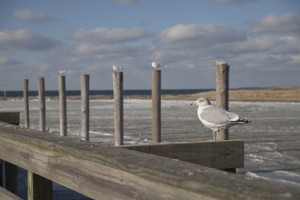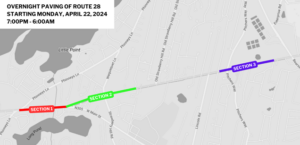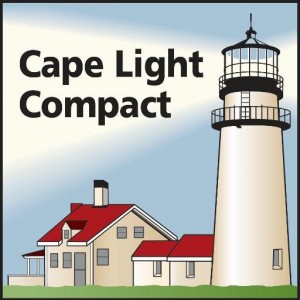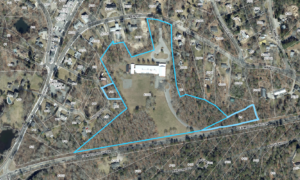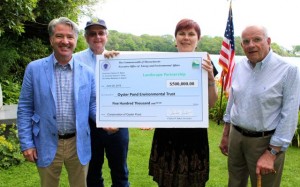
CCB MEDIA PHOTO
From Oyster Pond Environmental Trust, Jonathan Smith, Bill Kerfoot, Wendi Buesseler and John Dowling pose in front of Oyster Pond.
QUISSETT – The Oyster Pond Environmental Trust is now closer than ever to having all the funds needed to purchase a 22-acre parcel of land on Oyster Pond.
State Energy and Environmental Affairs Secretary Matthew Beaton was in town yesterday with a big check—$500,000 of the $2 million purchase price—and he announced the gift during a ceremony at Spohr Gardens, a private conservation parcel that is open to the public and which abuts the land OPET is planning to purchase.
OPET Executive Director Wendi Buesseler said the grant is important to the trust.
“We’re very, very close to meeting our goal to preserve and protect 22 acres of land on the Oyster Pond watershed. This is incredibly important land. It has two vernal pools, coastal wetlands and estuary shoreline. It’s very important wetlands. They are very key to protecting and preserving the health of Oyster Pond itself,” she said.
The town of Falmouth Conservation Commission will hold the conservation restriction on the land, and Buesseler said plans are to add trails within the year so the public can explore the property.
The trust’s goal is $2.1 million with the extra $100,000 for costs associated with purchasing land.
Beaton, who visited the property for the first time yesterday, said he was impressed.
“Being down here to be able to see this, I see what my friends in the legislature were saying. It is truly a very beautiful place that is in the area of some sensitive habitat,” he said. “There are a lot of benefits to preserving land such as this. It is an incredible natural resource and we were fortunate to have the legislative delegation bring this project to our attention early on.”
There are a lot of projects competing for funds and Beaton explained how his staff goes about analyzing them.
“You try to go through project by project. You have to factor in a number of things. You try to prioritize the need for certain projects, the impact of certain projects. You have to take into account timing of release of money. You try to look at every project holistically for all of the benefits and try to make the best decision possible. And this had so many benefits to the public, to the protection of a natural resource, to preserving biodiversity in such an area, and the timing was all there,” he said.
The money came through the Landscape Partnership Grant Program.
“Everything worked out that we were able to find some money early on in the Baker Polito administration to be able to fund what is such an amazing project to preserve such a beautiful place,” Beaton said.
Buesseler explained how the deal to purchase the land came about.
Two years ago the Woods Hole Oceanographic Institution was divesting itself of all properties not related to its mission, so OPET approached the institution about the purchase.
The land abuts OPET’s 7.5 acres in conservation land, as well as Spohr Gardens.
Altogether the purchase will create 34 acres of contiguous open space held in perpetuity against development.
The land had been gifted to WHOI by a scientist who wanted it used for either housing or open space. WHOI officials said they will use the $2 million gained through the sale of the property to build dormitories, which, in a way, makes possible both uses of the land.
OPET was formed 20 years ago when two groups came together, Buesseler said. The first group was made up of people who were concerned about the water quality of the pond which was being degraded from nitrogen leaching from backyard septic systems. At the same time, there was a group working on an effort to preserve open space, now called Zinn Park , which had been slated to turn into several houses.
“Our charge is to do anything related to improving and protecting the ecosystem and water quality of Oyster Pond,” Buesseler said of OPET’s mission.
One of the trust’s most visible projects is the removal of invasive species along the bike path where it travels alongside the pond. Trust volunteers have removed phragmites, and the change has been apparent. In 2006, bikers could not see Oyster Pond because of the invasives. “Now you have beautiful vistas of the pond,” Buesseler said.
In addition, Buesseler said, the shoreline habitat has come back. “There’s all kinds of native plants that are growing up in place of the phragmites, offering habitat, food and shelter for animals and fish,” she said.
The pond is also a heavily studied water body because of its proximity to Woods Hole. “There’s been a lot of scientific work done on this pond,” she said. “Because we’re so close to the scientific institutions, sometimes they come over and test new equipment.”
The conservation restriction on the purchase includes a provision to allow the land to continue to be available to the scientific community and to Falmouth schools for research projects approved by OPET and the Falmouth Conservation Commission.
Other donors to the purchase are town of Falmouth Community Preservation Act funds, The 300 Committee, Salt Pond Areas Bird Sanctuaries, the Compact of Conservation Trusts, Orenda Wildlife Trust and several foundations, as well as many private donors, volunteers and pro bono time.
Now that the trust is within “striking distance” of the purchase price, according to Buesseler, they are continuing to fundraise for the purchase but also thinking ahead to improving public access to the site with a small parking lot and bike racks.





